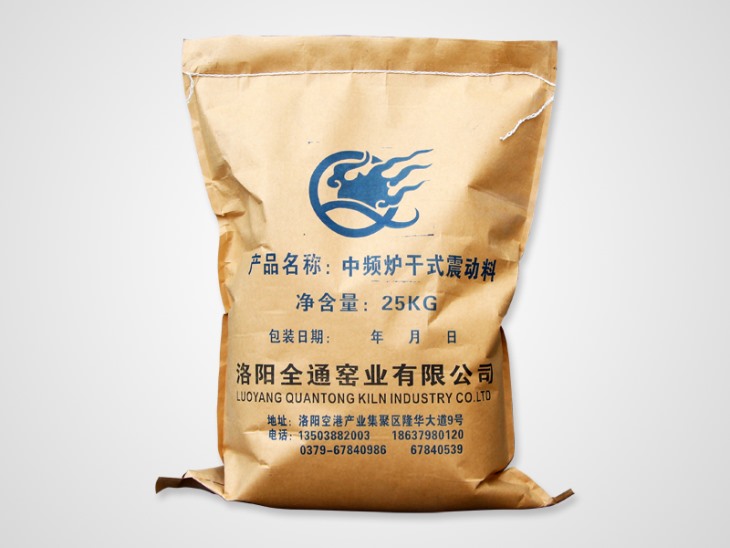Introduction of construction method of ramming material in intermediate frequency furnace
How to extend an intermediate frequency furnaceramming materialThe service life of the furnace? This is closely related to the furnace lining material, knotting technology, oven method, correct use, daily maintenance and maintenance.
1. Furnace lining material
When choosing furnace lining materials, you should pay attention to 2 points:
1. Confirm whether the furnace lining material used is an acidic furnace lining material or an alkaline furnace lining material.
2. Confirm the chemical composition and particle size ratio.
3. If the finished sand is used, it must be checked whether it is within the validity period, whether it is damp and the compressive strength is reduced.
2, knotting technique
The quality of the knotting quality of the furnace lining directly affects the service life of the furnace. Therefore, when the furnace is knotted, in addition to the process regulations, the following points must be paid attention to:
(1) Before tying the knot, the electrician, pliers, and foreman should be notified to conduct a comprehensive inspection, especially the cooling (waterway) system, the furnace tilting system, the control circuit, etc., and the furnace builder should follow up and confirm.
(2) Participants in the furnace are not allowed to carry anything, such as mobile phones, keys, watches and other items, and require everyone to be clean from head to toe.
(3) For the brick laying parts of the furnace bottom and furnace mouth, the brick joints should be less than 1mm, and the joints should be strictly staggered.
(4) When adding sand, it should be as low as possible, and spread evenly and evenly.
(5) The sand at the bottom of the furnace should be added at one time, and it is strictly forbidden to add it in stages.
(6) The method of "shaking first and then vibrating" is adopted when tying the knot. The rocker should be inserted to the end, first light and then heavy. Each time it is inserted, shake 8 to 10 times, and then knot after shaking. The order is the edge first and then the center.
(7) When lowering the crucible mold after the bottom of the furnace is knotted, it should be stable and straight. Make a ring-shaped 3-point fixing ring to fix the crucible mold at one time. In order to prevent the crucible mold from moving or floating when knotting Afterwards, place a special furnace-building press iron in the crucible. Appropriate melting furnace materials can also be added.
(8) After the crucible mold is finished, the sand around the crucible should be loosened to a thickness of 15-20 ram. Then add sand to tie the furnace wall.
(9) When knotting the furnace wall, the method of continuous knotting is adopted. The thickness of each batch of materials is 200280mm. After each batch of materials is knotted, the surface must be loosened by 1520ram and the next batch of sand materials must be added.
(10) In order to prevent debris from falling into the knotting process, a small shelf should be erected before knotting. If any debris falls into the sand, it must be taken out.
(11) The mouth of the furnace and the mouth of the furnace should be hammered with a small hammer, scraped with a scraper, and the inner side of the crucible should be chamfered approximately equal to 45 degrees Celsius.
(12) After knotting, use compressed air to blow off dust, sand and other debris that fall on the sensor. After knotting, the furnace should be evenly walled, without segregation layers, and the upper and lower layers are tightly connected without delamination. It has a large bulk density, and all parts of the furnace lining are uniform.
In addition, in the construction method of the ramming material in the intermediate frequency furnace, attention should also be paid to the oven and sintering. Strengthening the daily maintenance and maintenance is an important link to prolong the service life of the furnace lining.

Previous: Composition and performance of ramming material for glass kiln
下一条: The intermediate frequency furnace charge knotting process needs to pay attention to details sharing
Related Industry Knowledge
- Features and Benefits of Coil Clay
- What are the advantages of a good furnace lining
- Misunderstandings in the use of ramming materials in intermediate frequency furnaces
- Phenomenon analysis of failure of argon blowing of ladle permeable bricks and how to improve the rate of argon blowing
- Where is the consumption reduction and energy saving of breathable bricks reflected?
- How to improve the service life of intermediate frequency furnace lining
- Reasons for damage to intermediate frequency furnace lining and how to solve them
- The performance and advantages of breathable brick
- Analysis of Structural Characteristics of Dispersive Breathable Bricks
- The intermediate frequency furnace charge knotting process needs to pay attention to details sharing
- Composition and performance of ramming material for glass kiln
- Furnace lining manufacturers tell you how to improve the smelting speed of the intermediate frequency furnace
- Introduction to the difference between ramming material and castable material
- Do you know how the breathable brick is damaged?
- How to choose zirconium ramming material for glass kiln bottom
- Matters needing attention in the knotting process of wear-resistant ramming material
- How to use electric furnace lining to repair electric furnace
- Ramming material manufacturers tell you the influence of sliding nozzle refractories on breakout
- What should be paid attention to in material selection of intermediate frequency furnace charge
- Introduction to the construction of furnace lining ramming material


